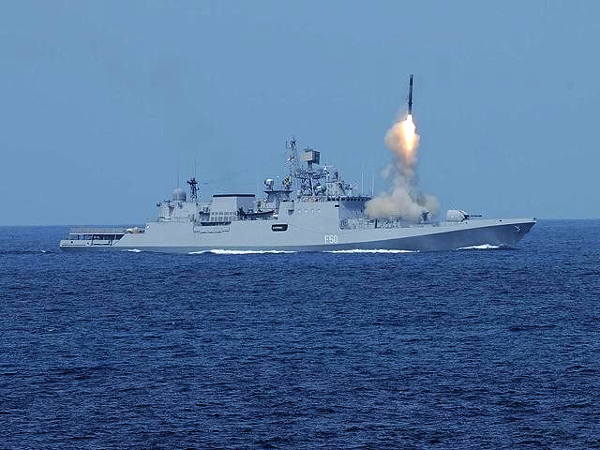With Air defence emerging as one of the primary tasks for a surface warship, the flight trajectory of the enemy supersonic air targets can be quickly acquired with accuracy using Artificial Intelligence (AI)/Deep learning(DL) data science.
In modern naval warfare, surface warships encounter hostile threats from air, surface, underwater and shore. With Air defence emerging as one of the primary tasks for a surface warship, the flight trajectory of the enemy supersonic air targets can be quickly acquired with accuracy using Artificial Intelligence (AI)/Deep learning(DL) data science.
This combination can be undertaken for the complete Fleet units simultaneously for re-orientation and create an impenetrable integrated air defence shield. Similarly, other threats like surface and sub-surface can also be handled together in an integrated manner within the AI framework. An enhanced operational capability in its fighting units enables rapid warship deployment in a fast-moving war scenario.
Outlining the advantages of AI concepts, Milind Kulshreshtha, C4I expert, says that this will help in identifying potential threats unambiguously and immediately using AI; it helps the command team make informed decision faster; rapidly detects and evaluate potential threats removing anomalies and AI is inherently designed to integrate itself into existing warship equipment suits to optimize their exploitation.
However, there are multiple factors which may emerge as a hindrance in effective implementation of AI in the Indian Navy, beginning with lack of Data science talent internally to identify AI issues themselves!
Mostly, the AI initiative for Navy has to emerge from within the organisation, rather than driven by external technology professionals. This is crucial since commercially available platforms are ‘data-scientist’ oriented solutions which Navy may find as undeveloped eco-system for enterprise-level exploitation, points out Kulshreshtha, who is behind several critical indigenous technologies for the Indian Navy.
According to him, the existing Tactical Data Link is an issue requiring a re-look to avoid it being a limitation for Naval Data servers connectivity with warships deployed at sea. Also, the role of manpower intensive work within firmly established Naval procedures is another complex issue to be overcome in the present machine age. Finally, the fears associated with AI becoming a self-learning monster too has limited reconnoitring opportunities due to lack of knowledge.
While the AI and DL have already made a permanent impact in all major fields like Finance, HR & Recruitment, Media etc., in the context of navy these can enhance existing operational capabilities to support MDA (Maritime Domain Awareness), Combat Management System etc. Also, ashore units involved in support roles like Logistics, HR Management, Dockyards etc. can make themselves more efficient and effective.
“By fusing sensor data, the Fleet Units at sea form a more accurate and reliable view of its environment for an intelligent situational awareness. Sensor data fusion provides a complete and accurate picture of its surroundings. The techniques that surround multisensor data fusion make up a very complex topic. Data processing techniques that associate, aggregate and integrate data from different sources help the system to build knowledge about certain events and environments, which is not possible using individual sensors independently,” he says.
Where can AI/DL be applied in the Indian Navy
Naval ship survivability is seen as a sub-component of ship’s protection against physical attack. In the threat perception scenario, this survivability is often seen in terms of susceptibility & vulnerability. These Threat Perspicacity computations can be evolved on the principles of Deep Learning.
The data and algorithms used in predicting missile engagement range define a Weapon Engagement Zone (WEZ). The WEZ algorithms are contained within the missile’s fire control computer onboard the ship. These values are calculated continuously in real time during flight with respect to a tracked target while the missile is still on the launcher. The WEZ information is displayed to the Operator, allowing the Command to make informed decisions when launching a missile.
Kulshreshtha said that use of an Artificial Neural Network (ANN) to perform the function for WEZ computation can be achieved by recording practice missile firing data and using this to train a multi-layer ANN using a specialised algorithm like Bayesian.
Source: FE
Image Courtesy: IDU
You may also like
-
IAF Aircraft Set Course For Exercise Eastern Bridge VII At Oman
-
IAF Set To Host The Indian Defence Aviation Exposition-II At Jodhpur
-
Defence Secretary to co-chair 5th India-Philippines Joint Defence Cooperation Committee meeting in Manila
-
Simultaneous Launch Of ‘malpe And Mulki’, Fourth And Fifth Ships Of Asw Swc (Csl) Project
-
Aatmanirbharta in Defence: MoD signs Contract with HAL for 240 AL-31FP Aero Engines for Su-30MKI Aircraft
